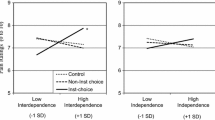Abstract
Undergraduate student volunteers either were given a choice of coping strategies or were assigned to a coping strategy which was used to help them tolerate the cold pressor. Subjects who were given a choice of coping strategies reported their strategy to be more credible and perceived a greater sense of control than subjects who were not given a choice. Improved pain tolerance, however, did not result directly from being given a choice. Increases in pain tolerance depended on locus of control. Subjects who had a high internal health locus of control reported a greater strength of self-efficacy and demonstrated increased pain tolerance following a choice of strategies. In comparison, subjects who reported a more external health locus of control did not benefit from receiving a choice. This study has implications for our understanding of the role of choice in therapy and for improving the effectiveness of our interventions with individuals.
Similar content being viewed by others
References
Ajzen, I., and Madden, T. J. (1986). Prediction of goal-directed behavior: Attitudes, intentions, and perceived behavioral control.J. Exp. Soc. Psychol. 22: 453–474.
Akins, T., Hollandsworth, J. G., and O'Connell, S. J. (1982). Visual and verbal modes of information processing and their relation to the effectiveness of cognitively-based anxiety reduction techniques.Behav. Res. Ther. 20: 261–268.
Altmaier, E. M., Ross, S. L., Leary, M. R., and Thornbrough, M. (1982). Matching stress inoculation's treatment components to clients' anxiety mode.J. Counsel. Psychol. 29: 331–334.
Averill, J. R. (1973). Personal control over aversive stimuli and its relationship to stress.Psychol. Bull. 80: 286–303.
Bandura, A., and Adams, N. E. (1977). Analysis of self-efficacy theory of behavioral change.Cognit. Ther. Res. 1: 287–308.
Borkovec, T. D., and Nau, S. D. (1972). Credibility of analog therapy rationales.J. Behav. Ther. Exp. Psychiat. 3: 257–260.
Byrne, D. (1961). The repression-sensitization scale: Rationale, reliability, and validity.J. Personal. 29: 334–349.
Devine, D. A., and Fernald, P. S. (1973). Outcome effects of receiving a preferred, randomly assigned, or nonpreferred therapy.J. Consult. Clinic. Psychol. 41: 104–107.
Efran, J. S., Chorney, R. L., Ascher, L. M., and Lukens, M. D. (1989). Coping styles, paradox and the cold pressor task.J. Behav. Med. 12: 91–103.
Glasgow, R. E., Klepac, R. K., Dowling, J., and Rokke, P. D. (1982). Measures of self-efficacy in pain tolerance. Paper presented at the annual AABT Convention, Los Angeles, CA, November.
Gordon, R. M. (1976). Effects of volunteering and responsibility on the perceived value and effectiveness of a clinical treatment.J. Consult. Clin. Psychol. 44: 799–801.
Kanfer, F. H., and Grimm, L. G. (1978). Freedom of choice and behavioral change.J. Consult. Clin. Psychol. 44: 373–376.
Keppel, G. (1973).Design and Analysis: A Researcher's Handbook, Prentice-Hall, Englewood Cliffs, N.J.
Lazarus, R. S., and Folkman, S. (1984).Stress, Appraisal, and Coping, Springer, New York.
Litt, M. D. (1988a). Cognitive mediators of stressful experience: Self-efficacy and perceived control.Cognit. Ther. Res. 12: 241–260.
Litt, M. D. (1988b). Self-efficacy and perceived control: Cognitive mediators of pain tolerance.J. Personal. Soc. Psychol. 54: 149–160.
Martelli, M. F., Auerbach, S. M., Alexander, J., and Mercuri, L. G. (1987). Stress management in the health care setting: Matching interventions with patient coping styles.J. Consult. Clin. Psychol. 55: 201–207.
McCaul, K. D., and Malott, J. M. (1984). Distraction and coping with pain.Psychol. Bull. 95: 516–533.
Melzack, R. (1975). The McGill Pain Questionnaire: Major properties and scoring methods.Pain 1: 277–299.
Mendonca, P. J., and Brehm, S. S. (1983). Effects of choice on behavioral treatment of over-weight children.J. Soc. Clin. Psychol. 1: 343–358.
Miller, S. M. (1979). Controllability and human stress: Method, evidence and theory,Behav. Res. Ther. 17: 287–304.
Miller, S. M. (1987). Monitoring and blunting: Validation of a questionnaire to assess styles of information seeking under threat.J. Personal. Soc. Psychol. 52: 345–353.
O'Leary, A. (1985). Self-efficacy and health.Behav. Res. Ther. 23: 437–451.
Phares, E. J. (1978). Locus of control. In London, H., and Exner, J. E. (eds.),Dimensions of Personality, Wiley-Interscience, New York.
Pickett, C., and Clum, G. A. (1982). Comparative treatment strategies and their interaction with locus of control in the reduction of postsurgical pain and anxiety.J. Consult. Clin. Psychol. 50: 439–441.
Rokke, P. D., and Lall, R. (in press). The role of choice in enhancing tolerance to acute pain.Cognit. Ther. Res.
Strickland, B. R. (1977). Internal-external control of reinforcement. In Bass, T. (ed.),Personality Variables in Social Behavior. Erlbaum, Hillsdale, NJ.
Strickland, B. R. (1989). Internal-external control expectancies: From Contingency to creativity.Am. Psychol. 44: 1–12.
Tan, S. (1982). Cognitive and cognitive-behavioral methods for pain control: A selective review.Pain 12: 201–228.
Thompson, S. C. (1981). Will it hurt less if I can control it? a complex answer to a simple question.Psychol. Bull. 90: 89–101.
Turk, D. C., Meichenbaum, D., and Genest, M. (1983).Pain and Behavioral Medicine: A Cognitive-Behavioral Perspective, Guilford Press, New York.
Turner, J. A., and Chapman, C. R. (1982). Psychological interventions for chronic pain: A critical review. II. Operant conditioning, hypnosis, and cognitive-behavioral therapy,Pain 12: 23–46.
Wallston, K. A., Wallston, B. S., and DeVellis, R. (1978). Development of the Multidimensional Health Locus of Control (MHLC) scales.Health Educ. Monogr. 6: 160–170.
Author information
Authors and Affiliations
Rights and permissions
About this article
Cite this article
Rokke, P.D., Absi, M.A., Lall, R. et al. When does a choice of coping strategies help? The interaction of choice and locus of control. J Behav Med 14, 491–504 (1991). https://doi.org/10.1007/BF00845106
Accepted:
Issue Date:
DOI: https://doi.org/10.1007/BF00845106




